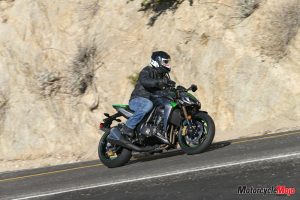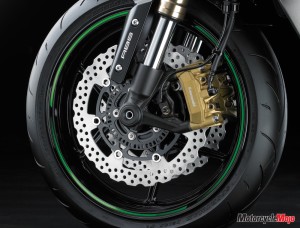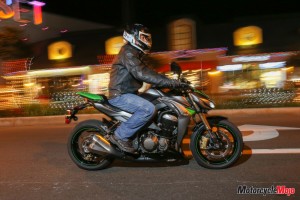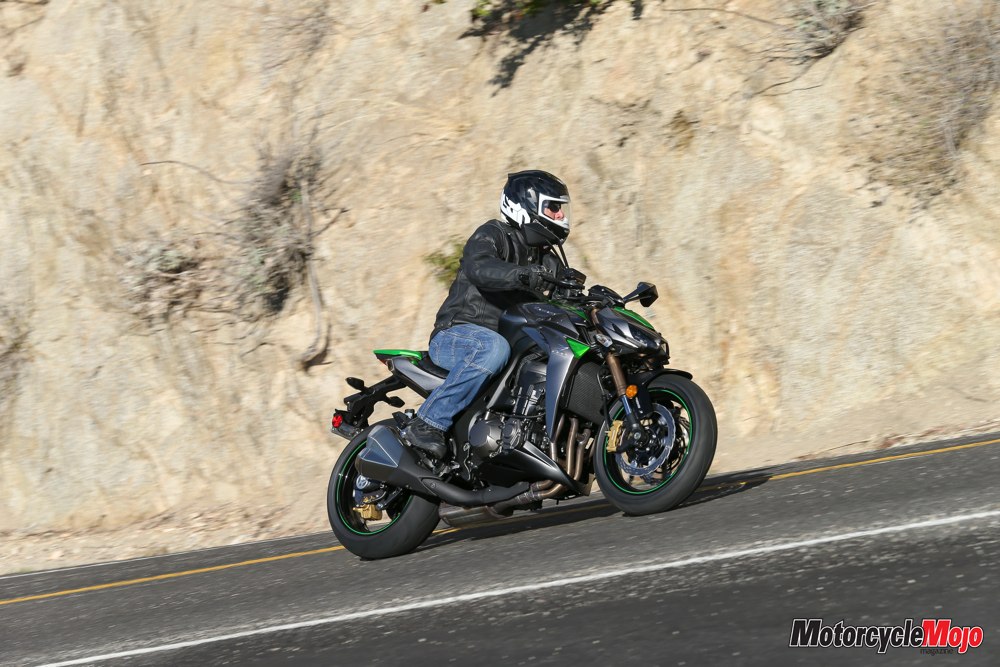Definitions of sugomi are all over the map. I think only the positive ones need apply
Kawasaki is proud to say that the new Z1000 was designed around the Japanese concept of sugomi. Kawasaki’s translation of the word is “the intense aura or energy given off by a person or object of greatness and felt by the viewer. Someone, or something, possessing sugomi inspires awe, leaves an indelible impression, is imposing in stature or ability, and commands respect.” To get another opinion of the word, a quick online search resulted in descriptions like weirdness, ghastliness, awesomeness, dreadfulness, intimidation – all of which could apply, depending on how you react to the looks of the new superbike-derived naked streetfighter. After all, beauty is in the eye of the beholder.
 The first view of this fourth-generation Z1000 causes mixed feelings. Particularly in the front half of the bike, its sculpted design is undeniably radical and could apply to all of my found definitions of sugomi. Some might call it weird or ghastly, while others might think the look is threatening or even awe inspiring. Many will like it just because it’s different and drastic.
The first view of this fourth-generation Z1000 causes mixed feelings. Particularly in the front half of the bike, its sculpted design is undeniably radical and could apply to all of my found definitions of sugomi. Some might call it weird or ghastly, while others might think the look is threatening or even awe inspiring. Many will like it just because it’s different and drastic.
Regardless of your thoughts on the bike as a whole, Kawasaki’s definition might fit it best. It does leave an indelible impression, it is imposing, it does command respect, and with a twist of the throttle, it does inspire awe.
Regardless of which side of the fence you’re on, you really shouldn’t judge this book by its cover. The Z1000 offers a refreshing approach to mechanical high tech, yet in this fast-paced world of electronic wizardry, the Z1000 also brings a back-to-basics approach to its user interface.
While the looks will factor a great deal into your initial response to this bike, there’s no denying that the 1043 cc engine is the jewel of the machine. Upon start-up, the growl from the truncated mufflers piques your interest, but clicking into gear, letting out the clutch and starting off will then demand your attention. Acceleration is velvety smooth, the non-adjustable, cable-operated clutch’s friction point is predictable, and the shifting is precise with a short throw of the lever. I sometimes find that high-powered, four-cylinder motorcycles can be annoying to ride in the city, but the Z1000’s fuel injection was flawless and the easy pull of the clutch was never a burden while I dealt with the stop-and-go foibles of riding in the city.
 The engine has been redesigned to provide low- to mid-range torque – right where the majority of streetbikes spend most of their time – and combined with shorter gearing, allows you to stay in a high gear at low rpm and still accelerate smoothly. Ideal if you’re feeling lazy while entering a town – the engine will pick up speed effortlessly even at 50 km/h in sixth gear. Top-gear passing is a breeze for this engine, negating the need for a downshift unless you desire to add more exhilaration to your ride.
The engine has been redesigned to provide low- to mid-range torque – right where the majority of streetbikes spend most of their time – and combined with shorter gearing, allows you to stay in a high gear at low rpm and still accelerate smoothly. Ideal if you’re feeling lazy while entering a town – the engine will pick up speed effortlessly even at 50 km/h in sixth gear. Top-gear passing is a breeze for this engine, negating the need for a downshift unless you desire to add more exhilaration to your ride.
At higher rpm, the throttle is easy to modulate without being touchy, and getting out on the open road is where Kawasaki’s definition of sugomi really comes into play. The ECU has been reprogrammed for a sharper throttle response, and a twist of the throttle releases an intake howl from the four throttle bodies that lets this predator lunge forward; the engine changes from a mild-mannered urban streetfighter to the instant rush of an aggressive, canyon-carving plaything ready to take on any challengers. To add to the enjoyment of the ride, the engine remains vibration free throughout its powerful rev range.
 Kawasaki has implemented a new, fully adjustable, big-piston, inverted fork on the Z1000. The front suspension provided great feedback in the corners and under heavy braking, and worked fine for both the city and aggressive riding in the canyons north of Los Angeles. The bike leaned into corners with very little effort on the bars and easily held the line, but on one particular left-to-right transition, I felt a little uncertainty. I blamed this on the stock suspension setting, and I have no doubt that it could be fine-tuned to perfection with a little fiddling. I did find the suspension too stiff on one exceptionally rough stretch of freeway littered with expansion joints, but again, this could be fixed with some suspension adjustments. The left fork tube looks after spring preload, while the right-side adjuster take care of compression and rebound damping, and both are easily accessible from the top of the fork tubes. The single, horizontal shock on the rear tucks neatly out of the way under the seat and is adjustable for rebound damping and spring preload.
Kawasaki has implemented a new, fully adjustable, big-piston, inverted fork on the Z1000. The front suspension provided great feedback in the corners and under heavy braking, and worked fine for both the city and aggressive riding in the canyons north of Los Angeles. The bike leaned into corners with very little effort on the bars and easily held the line, but on one particular left-to-right transition, I felt a little uncertainty. I blamed this on the stock suspension setting, and I have no doubt that it could be fine-tuned to perfection with a little fiddling. I did find the suspension too stiff on one exceptionally rough stretch of freeway littered with expansion joints, but again, this could be fixed with some suspension adjustments. The left fork tube looks after spring preload, while the right-side adjuster take care of compression and rebound damping, and both are easily accessible from the top of the fork tubes. The single, horizontal shock on the rear tucks neatly out of the way under the seat and is adjustable for rebound damping and spring preload.
Making contact with the pavement are Dunlop Sportmax tires designed specifically with the Z1000 in mind. Also new are lightweight, supersport-style wheels that are more than 1.5 kilograms lighter than the previous generation.
A pair of four-piston monoblock calipers slows the bike quickly, and the race-spec, radial-pump master cylinder provides excellent feedback with single-finger operation. A forceful single rear caliper squeezing a 250 mm petal rotor performs the braking duties on the rear; add to that the bike’s standard ABS, and you have some of the most potent braking available on a streetbike.
While there is absolutely nothing to dislike about the entire driveline, or the fit and finish of its collective parts, the styling of the front half of the bike could be up for discussion. There’s no question that its futuristic design sets it apart from anything else on the road. The array of four LED headlights sits low above the front wheel, reminiscent of the steely eyes of a crouching tiger ready to pounce. The fuel tank sits high, taking the shape of the big cat’s shoulders.
This is the first launch that I have been on where we rode at night in the city. After some time riding around downtown Los Angeles and Hollywood, the reason for this became apparent. Not only is the Z1000 designed as an urban streetfighter, but I’m sure our hosts wanted to show off the unique headlights on this fourth-generation Z1000. The streetlights did their part to light the route, but those headlights really cut through the darkness – and you can instantly distinguish them as a Z1000 in the mirrors.
One of the bike’s weak points, however, is the lack of turning radius. Designed as an urban brawler, the inability to turn tightly really limits its functionality in close confines. On the plus side, backing the bike up for three-point turns is easy, as the frame’s mid-section – and therefore the front of the seat – is narrow, allowing easy contact with the pavement.
The Z1000’s upright seating position is quite comfortable, as the bars rose up perfectly to meet my hands, and the foot pegs were positioned under my thighs to provide the right amount of bend in my knees and leverage to shift from side to side on the seat. During our daytime ride, we spent a number of hours carving canyons north of L.A., and I never once felt any ill effects of the thinly padded seat. But it might be a different story for a pillion. If you commonly carry a passenger, you might want to prepare them for their compact perch. Methinks this predator prefers to prowl solo.
The bottom portion of the LCD gauge includes a speedo, odometer and trip meters, clock, fuel gauge, fuel consumption, coolant temperature and a unique approach to displaying the tach. The first 4000 rpm discreetly registers vertically on the left side of the LCD, then the tach changes to the top display in a prominently displayed horizontal bar graph, making the rpm much easier to read at a glance.
It seemed a little odd to see such a futuristic-looking bike still using some basic hardware. The switchgear is basic, and the clutch and throttle are cable operated. Also a little odd for this style of bike is the lack of engine modes and traction control, which are becoming so common on many of today’s bikes. The only mainstream electronic convenience is ABS.
There are a number of factors that, in my opinion, make the Z1000 an attractive choice. The engine is silky smooth with excellent fuelling and low- to mid-rpm torque, the clutch is user friendly and easy to pull, and the transmission gearing completes a driveline that plays nicely with all the other components. On top of that, the bike is comfortable, has great brakes and exhibits excellent handling. At $13,499, version 4.0 of the Z1000 just might be the ultimate canyon carver and urban prowler.





























